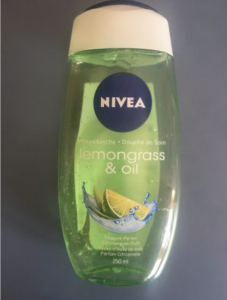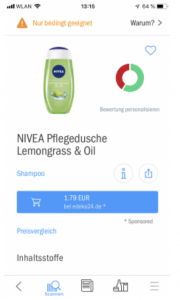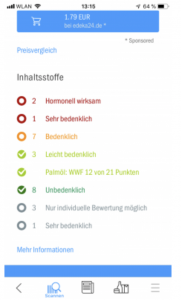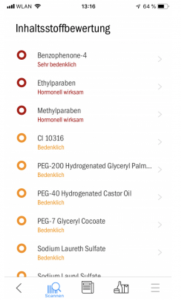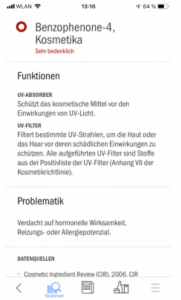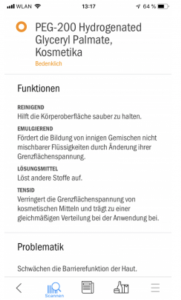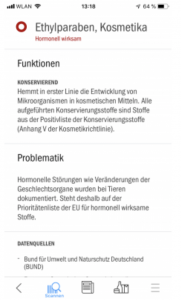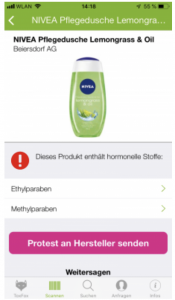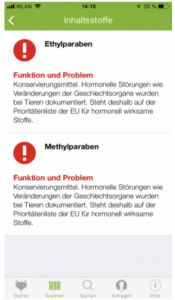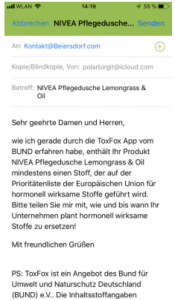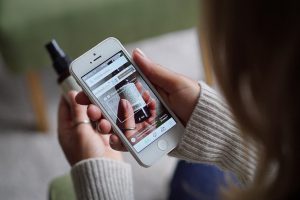
If you don’t have knowledge, you cannot act. That is why I am so enthusiastic about the many practical apps that are now available: With their help, you can find out about the ingredientsof almost any product in a matter of seconds, what is good and bad about these substances and whether the product as a whole is good or harmful. You can learn all this just by scanning the barcode. If you scan some of the products you use at home in your daily life with these free apps, you will be amazed at what you will learn. As a first step towards a life with less plastic, I therefore recommend you simply look up what you already have on your shelves. Then you can decide whether you want to continue using these products or, if necessary, look for alternatives.
Scanning the products I use myself really opened my eyes: I started in my bathroom, and although I only used (supposedly) high-quality cosmetic brands and personal care products for which I paid a lot of money, all of the products on my shelf were questionable and contained highly questionable ingredients. I didn’t have a single product in my bathroom cabinet that didn’t contain something that was marked red in the app and was therefore questionable. I promise anyone who cares to take a look that they will find what they are looking for in their own bathroom: plastic, palm oil, hormonally active substances, a whole mixed bunch, all right there in their bathroom cabinets. And not only there – but also in the fridge and everywhere else throughout the household.
This is important knowledge. This information should actually be transparently and directly displayed on the products. In fact, it should actually be the case that certain ingredients not be contained in products at all. And actually, it should really be the case that we can expect to find good and harmless products on our supermarket shelves, products that are neither harmful for ourselves nor for our world. Unfortunately, this is not the case – but as long as this information is missing, and manufacturers fail to inform us about what they put in the products we buy, you can make wonderful use of these new tools. I am happy to present some of these apps here.
Code Check – a huge database into which you can dive as deep as you want

CodeCheck is the app I use the most. There is hardly a product that you cannot evaluate with this app. 40 million products have now been added to the CodeCheck database. The app is free in its basic form, and it actually does everything you need. If you want the app without advertising, you can make a one-off payment of €6.99. I did this because I think the work of CodeCheck is so important that I was happy to pay this small price for this fantastic app. Once the app has been installed onto your device you can use it straight away: Simply scan the barcode of any product and the ingredients and their respective harmfulness or harmlessness are displayed. If certain aspects are particularly relevant for you, you can personalise the app and choose from four basic profiles: general, beauty, fit or green checker. There is also a blog about environmentally-friendly product issues.
As an example, I did a scan of the shower gel “Nivea lemongrass & oil”. I was shown the following result:
In the first window (1) you can see at a glance that a fairly large proportion of the circle is red – this means that the product contains a considerable proportion of questionable ingredients. If you want to know more, you can click (2) and find out how many ingredients have been classified and how – here two are hormonally influential, for example. In the third level (3) the individual substances are named. The fourth level (4, 5, 6, 7) finally explains why the product contains the agents, here for example: Protects the product from UV light and also what is problematic about it, for example: Hormonal disorders and changes in the genital organs have been documented in animals.
The data and its origin is also visible, which ultimately leads to the classification of the ingredients. The sources of the app include: The European Commission, Consumer Advice Center Hamburg, Federation for Environmental and Nature Conservation Germany, Greenpeace, Scientific Committee on Consumer Safety Europe, German Allergy and Asthma Association and a whole range of other institutes or associations.
For my lectures I scanned entire rows of shelves of regular cosmetics, shampoos, shower gels from german drugstore chains like Rossmann, dm and Müller. The result: The circle was not green in any of the products. It was only with certified natural cosmetics that I found entirely green circles.
You can find out more about the history of CodeCheck, the vision behind it, the financing, job opportunities and much more on the CodeCheck website.
Beat the microbead – the Plastic Soup Foundation app
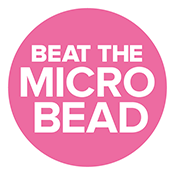
The Plastic Soup Foundation’s app, which is based in the Netherlands and displayed in English, primarily fights against the use of microplastics in products. It works exactly like the CodeCheck app: You simply scan the barcode and the result is displayed. Many people believe that microplastics are relatively easy to identify: beads in peels or toothpastes. If there is no bead in the product, there is no plastic in it. But that is sadly not the case.
The report by the United Nations Environment Program (UNEP) 2015 clearly showed that plastic is found in a wide range of products: As polyethylene (PE), polypropylene (PP), polyethylene terephthalate (PET), polymethyl methacrylate (PMMA), or nylon or a whole range of others.
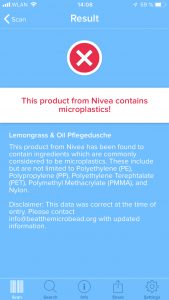
On the Beat the Microbead website, you can see a list of products, sorted by country, among other things, which shows whether a product contains microplastics or not. This list is constantly updated by NGOs. With this app I also scanned the Nivea lemongrass & oil shower gel. The following result was displayed to me – the product contains microplastics. The information doesn’t go any deeper here.
What is often criticized about this app is that many products have not yet been included. You can help to change that, for example by yourself contributing with the recording of the data. There is also information about this on the website of the app.
ToxFox – the app against hormones, protest option included

ToxFox is the app provided by the German Organisation for Environmental and Natural Conservation (BUND), which is directed primarily at ingredients that are hormonally influential. You can use it not only to find out whether a product contains such ingredients, but also to lodge a protest with the manufacturer against this substance – using a pre-formulated mail that can be sent with one click.
More than 80,000 products have now been added to the app, especially cosmetics and children’s toys. Like CodeCheck, the app then also shows the ingredients, their function and their respective cause for concern. Again, I had the app evaluate the now familiar shower gel. The result:
The first screen (1) shows that the product contains hormonally active substances. The second screen (2) explains what function these substances have in the product and what problems the substance entails. And, finally, in the third mask (3) you can write the pre-formulated mail to the manufacturer from your own mailbox. Of course, I did this. (Nivea then immediately sends you a pre-formulated email reply, arguing that all the ingredients used meet the legal requirements.)
If you do not have a smartphone, you can also simply enter the number below the barcode on the BUND website and receive an assessment as well.
No matter which app you use – you will be surprised by the results, mostly unpleasantly surprised. The knowledge acquired also shows you where it is most worthwhile to change something in your own household and environment in order to protect yourself, your family and your environment from unnecessary toxins. And that’s where you can start, step by step. I will show you a first step in my next blog.

